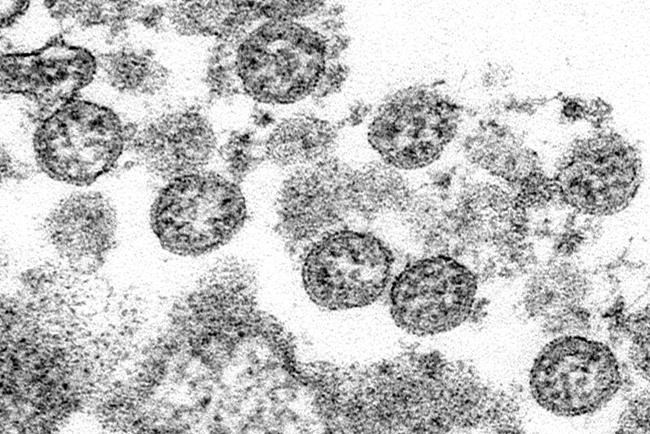
This 2020 electron microscope made available by the U.S. Centers for Disease Control and Prevention image shows the spherical coronavirus particles from the first U.S. case of COVID-19. THE CANADIAN PRESS/AP-C.S. Goldsmith, A. Tamin/ CDC via AP
June 10, 2020 - 1:00 AM
Thousands of scientists around the world are working on problems raised by the COVID-19 pandemic. Here is a summary of some recent research from primarily peer-reviewed academic journals and scientific agencies:
---
Dogs may become a useful diagnostic tool for COVID-19. Non-peer-reviewed research from France's Alfort School of Veterinary Medicine says eight dogs trained in cancer and explosives detection were subjected to 198 samples of armpit sweat collected from several different hospitals. The idea was to see if sweat from COVID-19 patients smelled different to them than sweat from healthy people. Four of the dogs were right 100 per cent of the time and none of them did worse than 83 per cent. While the paper is not conclusive, the authors suggest dogs could provide an inexpensive and accurate test for the illness.
---
The journal EMBO Molecular Medicine is warning that co-infections are adding significantly to COVID-19's toll. A paper points out that chronic obstructive pulmonary disease, which brings with it heavy bacterial infection, is commonly diagnosed along with COVID-19. Moreover, the authors say hospitals are a common source of bacterial infection, especially from ventilators, so COVID-19 patients are exposed to both. Other research has found half of patients who died from COVID-19 had secondary bacterial infections. The paper concludes that bacterial infections that come along with the novel coronavirus have been under-studied, and it warns that simply prescribing antibiotics will just create more resistant bacteria.
---
An editorial in the British journal BMJ lays part of the blame for the severity of the COVID-19 pandemic with the food industry. Researchers at Queen Mary University of London point out that obesity is one factor that seems to make cases of COVID-19 worse. They say the food industry should stop promoting unhealthy foods and drinks, and governments should regulate them to be healthier. They say levels of overweight and obesity have reached between 65 and 70 per cent in adult British and U.S. populations.
--
The journal Science is reporting how proteins act on the "viral spike" — the structure on the novel coronavirus used to get into healthy cells — when they are given to rabbits. Controlling the spike is considered one of the most promising paths toward a vaccine. Learning how different proteins affect it and stimulate the human immune system is part of that effort. Researchers found three proteins produced antibodies in rabbits that eliminated up to 98 per cent of the COVID-19 coronavirus. Researchers did not directly test their vaccine’s protective capabilities.
---
Northern California's COVID-19 epidemic came from many sources at once, says the journal Science. After analyzing viruses in 36 patients, researchers found viral lineages from Europe, New York, Washington state and China. No single source of the virus predominated. By May 4, California had 52,000 cases of COVID-19. The authors say the findings show the importance of public health measures such as travel restrictions and physical distancing.
---
The journal International Orthopaedics has used artificial intelligence to study the impact of different public health measures used in Canada, the United States and Sweden. Comparing rates of COVID-19 infection to the introduction of various public health policies, researchers found growth rates dropped at about the same time different measures came in. The drop was sharper for the U.S. and Canada were policies were stricter and were more gradual for Sweden. The author projects that by mid-June, rates in the U.S. will be trending downward and stable, while Sweden is likely heading in the other direction. Canada appears to fall somewhere in the middle.
---
This report by The Canadian Press was first published June 10, 2020
News from © The Canadian Press, 2020